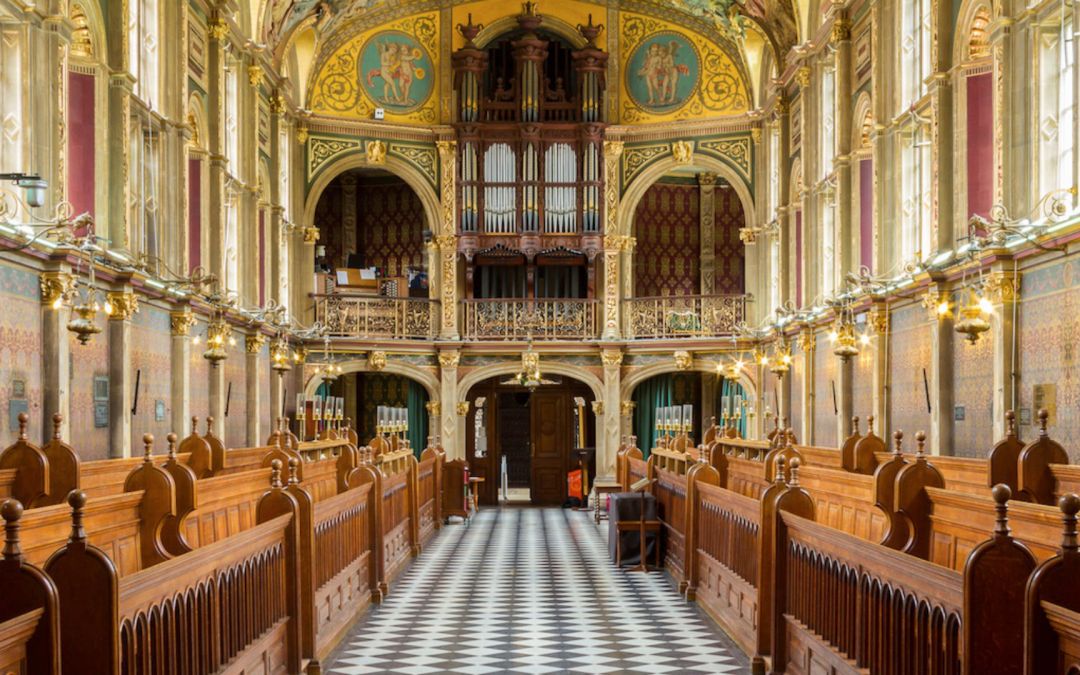Historic listed building receives perfect intelligibility with near invisible system that leaves all walls untouched
London, UK – March 2018… With gilded walls, bas-reliefs by Italian sculptor Ceccardo Fucigna and a fine manual organ, the chapel at London’s Royal Holloway College is widely celebrated as one of the world’s most beautiful university buildings. Completed in 1886, the non-denominational chapel remains an active place of worship for students and tutors of multiple faiths, as well as a focal point for the broader college community. Yet for all its splendour, the chapel is highly reverberant, having proven itself to be too much of a challenge for previous sound reinforcement systems. Now, a recently completed installation by renowned UK-based Whitwam AV Integration is using K-array to ensure the chapel sounds as impressive as it looks.
Part of the University of London, Royal Holloway College stands as one of the UK’s most prestigious seats of learning, and its college is no less respected. Yet as is the case with so many 19th century places of worship, the chapel’s interior was designed with a wealth of reflective hard surfaces.
“It’s all plaster, tiled floors and gilding – there actually isn’t a lot inside the chapel that is absorbent, aside from the people,” says Whitwam AV Integration’s David Harding, acknowledging the scale of the challenge that he and his team faced when considering an effective audio solution for the space. He adds: “then we started looking around to consider what might work aesthetically. Royal Holloway College chapel is beautiful, so a large, standard column speaker certainly wouldn’t be visually acceptable.”
While the project may have felt daunting for a less experienced systems integrator, Harding and his colleagues had reason to feel confident. Whitwam is well known for applying its unique blend of expertise and sensitivity to many of the UK’s most prized church buildings, from St Georges chapel at Windsor Castle, to St Margret Church in Westminster Abbey and Edinburgh’s St Giles Cathedral. Yet every project is unique, and this wasn’t the first time that loudspeakers had been added to the Royal Holloway College chapel interior.

“Our first step was listening to what was there originally, and deciding that we wanted to dramatically improve intelligibility and reduce the effect of the building itself,” explains Harding. “The previous system had loudspeakers positioned at a fairly high level, firing down and across the chapel with a conical response that meant a lot of the coverage just disappeared out towards the windows up on that high level – it didn’t sound too good.
“So our first decision was to put in a form of line source column, meaning the vertical dispersion would be reduced without the loss of effective horizontal dispersion. We knew that would also mean we could locate the speakers much nearer to the listeners, thereby reducing the effects of the building.”
A previous high profile project led Harding to think of K-array. “We used a stacked pair of K-array Vyper KV50 line array elements to overcome a very specific problem in Winchester Cathedral, and we were very impressed with them,” he recalls. “We felt they would be perfect for Royal Holloway chapel.”
A demonstration of the proposed solution received full support from exclusive UK K-array distributor 2B Heard. “They gave us all the support that we needed and they also did some EASE work for the project,” says Harding. “2B Heard’s assistance in the demonstration was critical.”
The chapel is now served by a highly innovative distributed K-array solution comprising 12 Vyper KV50 line array elements, positioned at regular intervals, at head height along the pews. The result is even, consistent and intelligible coverage, with no effects from the reverberant surroundings. Four Rumble KU44 subwoofers have been fitted beneath the chapel’s rear pews, providing precise low-end support. Power for the system is courtesy of two Kommander-KA24 power amplifiers.
Crucially, the chapel’s listed building status meant that Whitwam was unable to attach any equipment to the walls, but rather than reach a compromise that would adversely affect performance, the integrator used the compact dimensions of the Vyper KV50s to an ingenious advantage.
“We weren’t allowed to attach anything to the walls in any way,” Harding confirms. “But there is a wooden radiator grille that is no longer used by the chapel, and which runs between each of the pillars. So we designed a flat plate which sat over the grille, with a second plate beneath the grille and bolts going between the two. It means the timber of the grille is sandwiched between the plates and then the metal rod upon which the Vyper KV50 is mounted rises from the plates, with the cable running internally. So nothing is screwed in and there is no effect whatsoever on the building. If necessary, the installation could be removed at a future date and leave no marks at all, as if it was never there.”
The subwoofers are similarly installed. “Again we had brackets made for those – there were 1-inch vent-holes in the floor, and we picked up the fixing through those holes, with a plate beneath the floor to which the bracket is bolted. When the bolt is unscrewed the enclosure just comes off and there’s nothing fixed to the building.”
Most importantly, he adds that the completed installation “absolutely fulfilled our expectations in terms of sound quality, and also the hopes of our client. Our overwhelming reasons for using K-array in this project were the size of the speakers and their sonic quality. We are very proud of the result.”


You must be logged in to post a comment.